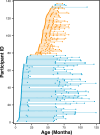This is a preprint.
Longitudinal trajectories of brain development from infancy to school age and their relationship to literacy development
- PMID: 39005343
- PMCID: PMC11244924
- DOI: 10.1101/2024.06.29.601366
Longitudinal trajectories of brain development from infancy to school age and their relationship to literacy development
Update in
-
Longitudinal trajectories of brain development from infancy to school age and their relationship with literacy development.Proc Natl Acad Sci U S A. 2025 Jun 17;122(24):e2414598122. doi: 10.1073/pnas.2414598122. Epub 2025 Jun 10. Proc Natl Acad Sci U S A. 2025. PMID: 40493188 Free PMC article.
Abstract
Reading is one of the most complex skills that we utilize daily, and it involves the early development and interaction of various lower-level subskills, including phonological processing and oral language. These subskills recruit brain structures, which begin to develop long before the skill manifests and exhibit rapid development during infancy. However, how longitudinal trajectories of early brain development in these structures support long-term acquisition of literacy subskills and subsequent reading is unclear. Children underwent structural and diffusion MRI scanning at multiple timepoints between infancy and second grade and were tested for literacy subskills in preschool and decoding and word reading in early elementary school. We developed and implemented a reproducible pipeline to generate longitudinal trajectories of early brain development to examine associations between these trajectories and literacy (sub)skills. Furthermore, we examined whether familial risk of reading difficulty and children's home literacy environments, two common literacy-related covariates, influenced those trajectories. Results showed that individual differences in curve features (e.g., intercepts and slopes) for longitudinal trajectories of volumetric, surface-based, and white matter organization measures were linked directly to phonological processing and indirectly to first-grade decoding and word reading skills via phonological processing. Altogether, these findings suggest that the brain bases of phonological processing, previously identified as the strongest behavioral predictor of reading and decoding skills, may already begin to develop by birth but undergo further refinement between infancy and preschool. The present study underscores the importance of considering academic skill acquisition from the very beginning of life.
Keywords: Biological Sciences/Neuroscience; MRI; brain; development; infant; literacy; longitudinal.
Conflict of interest statement
Competing interests: The authors do not have any competing interests to report.
Figures





Similar articles
-
Longitudinal trajectories of brain development from infancy to school age and their relationship with literacy development.Proc Natl Acad Sci U S A. 2025 Jun 17;122(24):e2414598122. doi: 10.1073/pnas.2414598122. Epub 2025 Jun 10. Proc Natl Acad Sci U S A. 2025. PMID: 40493188 Free PMC article.
-
Phonological Awareness Skills in Thai-Speaking Children: A Scoping Review.Int J Lang Commun Disord. 2025 Sep-Oct;60(5):e70099. doi: 10.1111/1460-6984.70099. Int J Lang Commun Disord. 2025. PMID: 40729430 Free PMC article.
-
Short-Term Memory Impairment.2024 Jun 8. In: StatPearls [Internet]. Treasure Island (FL): StatPearls Publishing; 2025 Jan–. 2024 Jun 8. In: StatPearls [Internet]. Treasure Island (FL): StatPearls Publishing; 2025 Jan–. PMID: 31424720 Free Books & Documents.
-
Gender differences in the context of interventions for improving health literacy in migrants: a qualitative evidence synthesis.Cochrane Database Syst Rev. 2024 Dec 12;12(12):CD013302. doi: 10.1002/14651858.CD013302.pub2. Cochrane Database Syst Rev. 2024. PMID: 39665382
-
Education support services for improving school engagement and academic performance of children and adolescents with a chronic health condition.Cochrane Database Syst Rev. 2023 Feb 8;2(2):CD011538. doi: 10.1002/14651858.CD011538.pub2. Cochrane Database Syst Rev. 2023. PMID: 36752365 Free PMC article.
References
-
- Siegler R., Children’s learning. American Psychologist 6, 769–778 (2005). - PubMed
-
- Kim Y.-S., Toward Integrative Reading Science: The Direct and Indirect Effects Model of Reading. J Learn Disabil 53, 469–491 (2020). - PubMed
-
- Wagner R. K., Torgesen J. K., The nature of phonological processing and its causal role in the acquisition of reading skills. Psychol Bull 101, 192–212 (1987).
-
- Wagner R., et al. , “The Nature of Prereaders’ Phonological Processing Abilities” (1987).
Publication types
Grants and funding
LinkOut - more resources
Full Text Sources
